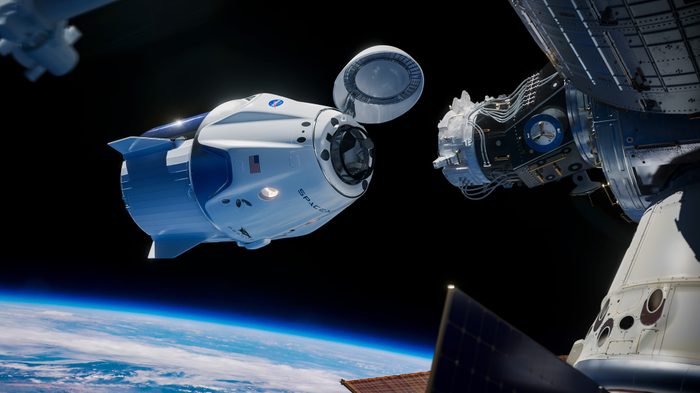Billionaires Want to Be the Gatekeepers of the Solar System

In this conceptual rendering of the near future, NASA assists U.S. private companies SpaceX and Moon Express to make outer space safe for colonial corporatocracy. Nearby, Virgin Galactic offers a luxury space tour, and SpaceX’s StarLink satellite system orbits Earth, while Chinese private company Origin Space begins mining an asteroid for precious metals. Illustration by Brian Cho
Space is the final (profitable) frontier—and it’s Elon Musk’s for the taking.
Space is our birthright. “Americans should have the right to engage in commercial exploration, recovery and use of resources in outer space,” President Donald Trump wrote April 6, 2020, issuing the “Executive Order on Encouraging International Support for the Recovery and Use of Space Resources.” In the stroke of a pen, Trump planted the U.S. flag on “the Moon, Mars and other celestial bodies.”
As Trump declared these space lands and resources open for business, you could hear the cheers — mostly from “moonshot” corporations that have clamored to sweep away the patchy, unregularized Cold War-era space law in favor of new, unregulated corporate plunder of the solar system.
While the institution of private land ownership is now widely taken for granted, it was — like many so-called natural things — invented.
Before the muddied, grueling transition from feudalism to capitalism, peasants in Britain and much of Western Europe depended on their right to farm, forage and harvest on common, community lands. The land was controlled by local lords, but it belonged (in a loose, de facto sense) to the communities living on it and dependent upon it. Eventually, common lands were “enclosed” and became the private property of aristocrats.
This exclusive right to land use (to own and profit from land) was the contrivance that established the new economic order. No longer held in common, the planet’s resources were parceled off to strictly private hands. No longer could peasants scrape by, subsisting on the commons. Instead, they depended on the grace and favor of a wage.
Life in feudal times was no bucolic idyll, but enclosure was synonymous with disaster, destitution and death for many people. This model was mirrored in the capture, theft and enclosure of colony lands, the people (and resources) of which fueled the early capitalist transition and later the industrial revolution. Capitalism must grow to persist, and as it grows it must transform ripe, unregularized commons into private fiefdoms — at home and afar.
So it seems only “natural” to carve up the moon into stretches of valuable real estate, just like Manhattan and the metal mines in the Democratic Republic of Congo. After all, Earth’s resources dwindle by the day, and boundless resources beyond the stratosphere could be a backstop for planetary scarcity. Never mind that our crisis of resources is, in part, the result of this system of private ownership that rewards ruthless, short-term profiteering at the expense of the long-term survival of the natural commons.
This future access to a new natural commons is now a stress test on governmental priorities. As Trump proclaimed, “Outer space is a legally and physically unique domain of human activity, and the United States does not view it as a global commons.”
Trump’s executive order to “encourage international support for the public and private recovery and use of resources in outer space” heralds yet another public-private boondoggle, where nominally public institutions thrash out fresh boundaries of corporate activity. As an example, look no further than SpaceX’s Crew Dragon capsule, which successfully transported NASA astronauts Bob Behnken and Doug Hurley to the International Space Station on May 31, 2020. The NASA-SpaceX crossover branding leaves no room for misinterpretation: The next small steps for mankind will be giant leaps for corporate America.

To Big Business…
Elon Musk, who founded SpaceX in 2002, talks misty-eyed about a relatively near future when humanity will have risen out of the mud, setting its sights on colonizing Mars — with SpaceX transportation rocketing there.
In 2020, Musk began launching a cavalcade of thousands of satellites into low-Earth orbit to form the Starlink satellite system. As of November 2020, nearly 900 satellites had been launched (42,000 are planned in total). This network will potentially seed an extraplanetary monopoly for key economic infrastructure, such as domestic internet access.
Fellow billionaire escapist Jeff Bezos, Amazon CEO, has been romanced by the wealth among the stars as well, founding his own aerospace company, Blue Origin, back in 2000. “We are going to build a road to space,” Bezos said in 2019. “And then, amazing things will happen.”
Bezos has invited us all to cosplay his daydreams with the Amazon-funded, interplanetary sci-fi thriller The Expanse, in which a roll call of stock anti-heroes (the rogue policeman, the war-beleaguered pilot, etc.) tumble through a far future when only wise plutocratic innovators can plumb interstellar riches and deliver the solar system from interstellar war.
Microsoft, too, has its fingers in the intergalactic pie, launching Azure Orbital in September 2020 to enable satellite operators on its cloud computing platform, along with a SpaceX partnership the following month.
According to Forbes, 2019 was a record year for private space investments, with “venture capitalists [investing] $5.8 billion in 178 commercial space startups worldwide.”
As Earth’s billionaires burnish the power of new stratospheric tech, Trump launched Space Force, the first new branch of the U.S. military in more than seven decades. “Space is the world’s newest war-fighting domain,” Trump said. “Amid grave threats to our national security, American superiority in space is absolutely vital.”
Space exploration has long been tied to military ambition. From its Cold War founding, NASA’s task was to advance the practical interests of the American state as it squared off against the Soviet behemoth. The new field of battle included space-guided missiles and satellite technology. Astronauts are still generally selected from the ranks of the military. Grumman (now better known as half of Northrop Grumman) made parts for both the NASA spacecraft that leapt into the great unknown and the military machines that waged war in Vietnam.
As the shadow of nuclear war retreats in the bright light of a digital dawn, the mission of Space Force is to protect the economic and military infrastructure (communications and surveillance technology) seemingly threatened by rival global powers (namely, Russia and China) gearing up their own military space operations.
The 1967 Outer Space Treaty, signed by the United States, the United Kingdom and the Soviet Union, attempted to guard against the militarization and the privatization of our shared stratosphere. The treaty limited governmental (and non-governmental) bodies from sending nuclear weapons into space and prohibited the annexation of the moon and temptingly mineral-rich asteroids. As the treaty outlined, any country could use and explore outer space but there could be no “appropriation” of astral territory. It was, at heart, a disarmament treaty — one whose ropey legalities were enforced by the now-defunct Cold War brinkmanship between its main two signatories.
The treaty never foresaw the dizzying rise of private enterprise clamoring for a slice of the sky. Nor did it foresee the slow shelving of publicly funded U.S. space exploration (especially the manned variety) that would allow venture capitalists to stake their claim in a new space scramble.
With all new technology, regulation lags behind it, forced to play catch-up. Sean Casey, for example — formerly of NASA and now at Silicon Valley Space Center — has championed a “regulatory framework that allows for the growth of the industry.” Congress has obliged, and the purview for private commercial space ventures has been wedged wide open.
The 1967 treaty had been interpreted by the United States in a manner akin to maritime law; just as no country owns international waters (making for open fishing), no country could own space (but loads of moon dust and modest astral bounties could be hauled back to Earth). The SPACE Act of 2015, however, elaborated on President Barack Obama’s expanded use of public-private partnerships for space exploration, making near-Earth asteroids available to commercial ventures. This law paved the way for the 2017 American Space Commerce Free Enterprise Act, designed to “ensure that the United States remains the world leader in commercial space activities.”
Many of the first asteroid-mining companies have collapsed; Planetary Resources and DSI, for example, failed to raise enough money to build the needed speculative infrastructure. But the prize is too big to lose. The race is now to secure ownership frameworks in anticipation of mining technology eventually catching up to ambition. The SPACE Act slashed that red tape, and things are looking up. In November 2020, for example, founder of Trans Astronautica, Joel Sercel, said “five years ago was, we think, the wrong time” for asteroid mining, but there is reason “to go to asteroids in the near term.”

…And Beyond!
The halcyon age of space exploration, when all American men took giant steps for mankind, looms disproportionately large in the collective U.S. imagination. In reality, the era was astonishingly brief. After President Richard Nixon ended the Apollo missions, every subsequent president promised to renew that muscular spirit of idealism and conquest. So far, no one has.
In 2018, Trump instructed NASA to defund the International Space Station by 2025. NASA is increasingly reliant on private companies to deliver on its contracts. In fact, the Trump administration’s FY2020 budget included $363 million to “support commercial development of a large lunar lander that can initially carry cargo and later astronauts to the surface of the Moon.” And NASA’s Artemis program aims to put people on the moon by the middle of the decade as a commercial enterprise. It has also tapped three companies — Astrobotic, Intuitive Machines and Orbit Beyond — for a $253.5 million project to develop robotic landers partly for “commercial enterprises.”
Meanwhile, SpaceX has been busily launching people off the planet. With its government contracts, it has grown from a $52 billion valuation in July 2020 to more than $100 billion three months later.
NASA still carries out extraordinary amounts of research— research that has provided the basis for the “genius” leaps forward of the Silicon Valley aristocracy. Economist Mariana Mazzucato notes that private innovation is often rooted in publicly funded research, to say nothing of the mammoth taxpayer-funded task of building initial infrastructure. Indeed, the aeronautic industry was largely dependent on government haulage and courier contracts until dwindling costs made commercially affordable flights possible, which crisscross our skies today. When it comes to space exploration, neoliberalism has reformulated the capacity of public bodies (and their spending, organizational and disciplinary frameworks) into a huge tendering system for the benefit of for-profit contracting corporations.
Recent years have seen an explosion of spacefaring venture firms and private spaceflight startups. Spaceflight offers “rideshares” for satellites wanting to hitch lifts on bigger ventures. Planet offers digital satellite imagery, and Spire Global deals in satellite-driven data analytics “so that businesses and governments can make smart decisions.” Axiom Space and billionaire Richard Branson’s Virgin Galactic are two of many companies attempting to pioneer — aka capture the market — in luxury space travel. Orion Span promises an “authentic astronaut experience” in its Aurora Class Space Station, a luxury space hotel complete with high-speed internet and zero-gravity ping pong, for which it charges $9.5 million a trip. At the most harebrained extreme, the so-called Space Nation of Asgardia offers a warped utopian experiment in off-world living — part cult, part country club, part time capsule, part political refuge — and another exercise in satellite development and data management.
Three of the most tantalizing opportunities — and perhaps the most competitive markets — are those for communications infrastructure, asteroid mining and missions to the moon. Anyone who owns or runs a monopoly on satellite communications infrastructure can charge rent. SpaceX formerly acted as a transport service for other enterprises’ satellites; today, its Starlink promises a whole new infrastructure of its own. Mining initiatives like the U.K.’s Asteroid Mining are prospecting the estimated $700 quintillion of rare earth minerals in the asteroid belt. Those materials are key to the manufacture of digital technology and robotics — rare on Earth, but abundant in our sky.
“The moon is hot again,” said Jack Burns, director of NASA’s Network for Exploration and Space Science, in an interview with the New Yorker. The moon’s low-gravity conditions, its proximity to Earth and its natural resources make it a prime hub for further space exploration, refueling and commercial operations.
Bezos has expressed an interest in using low-gravity conditions for heavy industries, such as mining and manufacturing. Made in Space, a California startup, already has produced fiber optic cables in space. Moon Express is one of a number of companies planning to send commercial missions to the moon to mine for things like water (precious in space) and platinum (precious on Earth).
In 2017, the head of China’s lunar exploration program compared the moon to the Diaoyu/Senkaku Islands — a collection of uninhabited rocks in the East China Sea with enough strategic importance to cause decades of conflict among Asian nations. Many suspect oil is under the sea near the islands.
The Artemis Accords, signed in October 2020 by the United States and seven other countries, tries to lay out norms and suggestions for avoiding conflict over space resources. Any anxiety about such an agreement has not dulled the ambitions of the venture-corporate forces that underwrote it.

Just One More Frontier
The eye-watering upfront costs of these exploratory, high-risk, high-reward endeavors can be absorbed by Silicon Valley venture capitalists and the personal fortunes of its aristocracy. A concentration of capital stands ready to risk big money to secure a stake in future markets (which will double down on its power in existing ones). The point is to ensure a slice of the territory everyone else will be clamoring for.
This form of “creative destruction”—an idea developed by economist Joseph Schumpeter, understood in neoliberalism to describe the boom-bust cycle of innovation — is often packaged in the mythology of moonshot genius that drives human progress. But Schumpeter’s theory has a less discussed underbelly: Such creative destruction is usually twinned with market capture. As competitors are tossed onto the scrap heap of history by their own sudden irrelevance, oligarchies and monopolies flourish.
The riches of the asteroid belt make earthly mining look positively parochial. The problem is that a sudden, vast supply of (formerly) precious metals would make market prices plummet.

Journalist Aaron Bastani, author of Fully Automated Luxury Communism, notes that satellite-delivered digital information has the potential to replace our earthbound Internet networks with “space-based global Internet” — the way music streaming has replaced CDs and CDs replaced cassettes and vinyl — or to at least render them much cheaper (through, for example, open-access 3D printing). SpaceX and Blue Origin surely share a goal to make space transport cheaper. The question is, for whom?
These ventures train their sights on infinite excess, with dwindling marginal costs as the supply of key materials and digital resources expands. This paradigm is great for those interested in the advancement of human civilization, but not so much for a grinning billionaire’s fixation on the bottom line.
At first glance, expanding industry beyond Earth sounds like a pragmatic fix to the earth-shatteringly simple dilemma faced by capitalism: that it must grow to survive, but the planet it grows upon is finite. But to maintain profit margins in conditions of plenty (a demand of industry), legal and political fixes are required. If you exclusively own mining rights to asteroids rich in platinum — and precious little platinum is left on Earth — you can charge whatever you like for platinum. The diamond industry perfected this technique decades ago. (Elon Musk’s family fortune comes partially from a Zambian emerald mine.)
Hence, the focus of the new space race is not on the production of goods or their most efficient sourcing, but on ownership of land and transport networks. In this latest phase of capitalism, as national growth slows, productive industries dwindle and wealth concentrates in fewer hands. As economist Thomas Piketty has observed, this phase is accompanied by a pivot toward rent-seeking as a profit mechanism.
In other words, the scramble for space is the scramble to own satellites and “starways,” gatekeep the riches of the solar system and charge rent on the moon. Against this backdrop, Space Force might seem retrograde, a warped nostalgia for a time when the space race was about petty terrestrial wars rather than Musk’s supposedly enlightened vision to colonize Mars.
In reality, the two visions go hand in hand. Military might physically captures and secures territory, enforces the American political and legal apparatus and ensures business can function (even on the moon).
The darlings of this new space age paint their vision as daring futurism, a wild-eyed libertarian dream of human elevation. But history repeats and the story is old. Like Bezos and Musk, Cecil Rhodes — mining magnate and premier villain of the British Empire — also succumbed to dreams of wealth in the night sky. “Expansion is everything,” Rhodes said. “I would annex the planets if I could.” Where technology opens up the yawning unknown of new territory glittering with potential profit, private enterprises hustle for dominance — backed by the military and legal capacities of earthbound nations.
Colonialism in space is not some post-humanist utopia, but the age-old dominion of land barons and mining magnates, billionaires sloughing off the wreckage of one planet and setting out for the stars.
Eleanor Penny is a writer, poet and essayist based in London. She is a senior editor at Novara Media. Her work can be found in outlets including Verso Books, the New Statesman and Novara Media.






